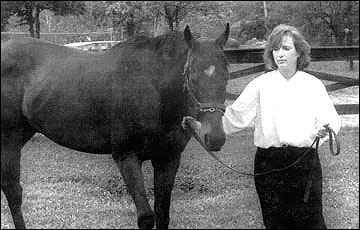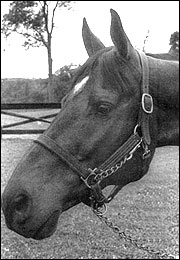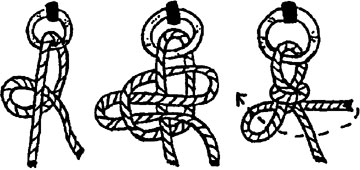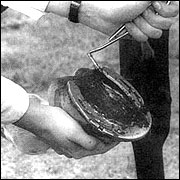During the last decade, participation in horse-related activities has continued to grow. The National Safety Council estimates that more than 10 million people in the United States are involved in equine sports. Membership in many horse associations has grown steadily.
These numbers reflect the importance of safe horse handling at every level. Basic safety practices are essential in every horse operation. This publication describes some important safety precautions that should be taken to ensure that you have a safe and enjoyable experience with your horse.
Basic horse behavior
The key to true horsemanship is to respect your horse and to be patient with it. Likewise, the horse must be taught to respect its handler. In order to develop these traits and to maintain your safety, you must understand the horse's behavior.
Horses survive in the wild because of their instinct to flee from danger. This is called the "flight instinct." Therefore, horses may react to unfamiliar objects and circumstances by spooking, or fleeing, from the object of fear. Horses detect danger through their vision, sense of smell and keen sense of hearing. Remember that when a horse spooks at "nothing," it may be reacting to something it can hear that you cannot.
Horses also see differently than humans do, and they can be easily spooked if surprised. They have wide-angle vision, but they also have blind spots directly behind and in front of themselves. The horse has to position its head to focus its vision, and when it focuses on one area, it cannot see the other areas clearly. For example, when it lifts its head and pricks its ears, it is focusing on something far away. The horse lowers its head when focusing on low, close objects. Keep these blind spots in mind and know where your horse's attention is focused so you do not scare it.
Your horse's ears will give you clues, too — they will point in the direction in which its attention is focused. Ears that are "laid back," or flattened backward, warn you that the horse is getting ready to kick or bite. Know the difference between ears that are laid back and ears that simply indicate a resting or listening horse.
Horses have powerful hind legs to defend themselves, so it is only normal for them to kick when surprised. Spoiled horses that kick or strike out of habit, however, should be left for professional horse trainers to handle.
Always work with calm but deliberate movements around horses. Nervous handlers can make horses nervous, creating unsafe situations. Never, ever lose your temper or blame your horse for your mistakes. It is best to quit for the day rather than take out your frustrations on the animal. Administering proper, consistent discipline is important for maintaining safety, but there is never a good reason for losing your temper. It only makes unsafe situations worse, either scaring the horse or causing it to retaliate.
Approaching the horse
When catching a horse, approach from its left shoulder, holding the lead rope in the hand nearest the horse and the halter in the opposite hand. Move slowly but confidently, speaking to the horse as you approach. Read the horse's intention by watching its body language. If it shows signs of moving away, move more slowly, or move away and head it off before it goes too far in another direction. Be careful not to get into a situation where you could get kicked, which can happen if your horse feels cornered or threatened.
Some people use feed to catch their horses, but it is best to teach your horse to be caught without feed, particularly when it is turned out with other horses. The other horses may crowd you and you could get stepped on.
Once you are able to touch your horse, rub it on the neck and slowly place the lead rope over the neck. Moving your arms too quickly could encourage it to run from you. Standing alongside the horse's neck, slide the halter on the horse by bringing it upwards on the muzzle and over the head, being careful not to drag it over the nose, eyes or ears. Rough handling can cause horses to become head-shy, making haltering and bridling more difficult.
Adjust the halter with enough room at the throat to slip a hand between the throatlatch and the horse's jaw. The halter should be tight enough to prevent a foot from getting caught when the horse lowers its head, yet have sufficient room to prevent binding the throat.
Be careful when approaching a horse that is preoccupied, such as when its head is in a hay manger. When approaching a horse in a stall, speak to the horse to get its attention and wait until it turns and faces you before entering. It is harder to escape a dangerous situation within the confines of a stall, so always make sure you have an "out."
If approaching a horse in a tie stall, make sure the horse moves over before you walk in beside it.
Speak to your horse and keep your hands on it when moving around it. Even if a horse is aware of your presence, it can be startled by quick movements. When approaching from the rear, advance at an angle. Speak to the horse, make sure you have its attention, and touch it gently as you pass by its hindquarters.
Leading the horse
Hold the lead line with your right hand, 8 to 10 inches away from the horse's head, while holding the end, or bight, of the line with your left hand. If the horse acts up, you can let go with your right hand, but still hold on with your left hand. Always use a lead line so you have this "safety zone" and to prevent getting a hand caught in the halter.
Teach your horse to walk beside you so that you are walking at its left shoulder. Hold your right elbow near the horse's shoulder so you can anticipate its actions. Horses must be taught to move away from pressure so they do not crowd or lean when you try to push them away. If you are leading an unfamiliar horse, or a horse that tends to be fresh, you may want to put a chain over the nose for more control. Do not let the horse "walk" you. Do not allow it to get behind you either, as it could jump into you if spooked.

When changing directions, turn the horse away from you so that you do not get stepped on (Figure 1). To lead a horse through a doorway, make sure there is enough room so that it will not bump its sides. You should step through first, then quickly step to the side out of the horse's way. Keep an eye on it, as some horses try to rush through narrow spaces.

The bight of lead lines and longe lines should be folded in the left hand to prevent handlers from stepping on the line or getting their hands caught. When folding is too bulky, coil the line in large loops like a lariat, but be sure the loops are not so big that you might trip over them. Never wrap any piece of equipment attached to a horse around your hand, even with small loops, as it could wrap around the hand and cause serious injury. If the horse pulls away from you, the loops can slide through your hand, entangling your fingers very quickly. Do not underestimate this danger! Many handlers, amateur and professional, have suffered serious injuries such as lost fingers and maimed hands in this way.
If your lead line has a chain on the end, do not loop it through the halter ring under the chin and back to itself. If the horse lowers its head, it could get its foot caught in the loop of the shank. Instead, you should either put the chain over the horse's nose, or put it through the halter ring on the left cheek and hook it to the throatlatch ring (Figure 2).
Tying the horse
There are two ways to tie a horse: tying with a single lead and cross-tying. When tying with a single lead, tie to a solid fixture, such as a post or a ring in a solid wall, and use a quick-release knot (Figure 3). Some horses learn how to untie a quick-release knot, so you may have to put the end of the line through the loop.
Always tie with a lead rope and not with reins. When tying to a hitching rail, stagger the horses on both sides so that they cannot fight. Tie horses far enough from the end of the rail so that they cannot move around to the other side.
Tie the horse at or above the level of its withers, and tie it short enough that it cannot lower its head and get a foot over the lead. The horse should be able to stand with its head at a comfortable level. Never tie to wire fences, posts where the knot could slip to the ground, or to anything that may come loose if the horse pulls back. If tying a horse in a stall, do not tie to the stall door. A panicked horse could pull the door off its hinges and drag it.

Do not leave your horse tied up without supervision, especially if it is alone. The horse is a herd animal and may panic if left alone, possibly injuring itself or the person who tries to free it.
Cross-tying can be dangerous if not done properly, so it should be done only where there is secure footing, if possible where there is a wall a few feet behind the horse to keep it from backing up too far. Use cross-ties with safety snaps and set them high in the wall to prevent the horse from getting a leg over if it rears. The cross-ties should be made of material that can be cut quickly, and should be tied with enough slack for the horse to hold its head comfortably. Do not use rubber ties. If the horse pulls back, rubber ties can throw the horse backward if they break or forward when the horse gives. Never leave a horse unattended on cross-ties.
Always untie the horse before removing its halter. When turning it loose, lead it through the gate and turn it around to face the direction from which you entered. It is safest to remove the halter, but if you must turn him out with a halter, use a leather one because it will break more readily than nylon if the horse becomes entangled. After you remove the halter, make the horse stand quietly for several seconds before letting it go completely. This will help prevent the horse from developing a habit of bolting away and kicking at you in the process. Make sure you have an escape route in case the horse spins around and kicks out.
Grooming the horse
Wear hard-toed boots to protect your feet in case you get stepped on. Do not wear tennis shoes or open-toed sandals. Also avoid wearing dangling jewelry and pull back long hair so that it does not restrict your vision or get caught.
Use grooming equipment gently on your horse, particularly on animals with sensitive skin. Some horses can become sour and begin nipping at you if they anticipate discomfort during grooming. Be sure not to leave your equipment where the horse could step on it.
Stay near the horse and keep a hand on it at all times so you can anticipate its movements. Never sit on the ground or groom from your knees, and always be in a position to move away quickly. Do not hurry the grooming procedure, especially with a young or spooky horse.
Begin grooming with a rubber currycomb, which is more gentle than a metal one. Start on the neck and brush in a circular motion. Work from front to back, grooming carefully in bony areas. Avoid using the currycomb on the face, lower legs or flanks.
You may use a shedding blade to remove shedding hair, but be very gentle, especially on bony areas or if the horse is muddy. Do not use the shedding blade on the mane, tail or legs.
After you have loosened the dirt and hair, use a brush to remove it. If using two brushes, use the stiffer one first, but avoid brushes with extremely hard bristles. Start on the neck and brush with the hair, working from front to back. Be sure to clean the horse's belly where the cinch lies to prevent saddle sores.
The stiff brush also can be used in a side-to-side motion to remove mud on the feet and legs, but it may be necessary to wash mud from the lower legs rather than groom roughly to remove it.
Use a soft brush to put on the finishing touches and to brush the face. Untie the horse when brushing its face, and work slowly and gently, as many horses are sensitive. Hold the halter in one hand, or drop the halter around the neck and place one hand over the horse's nose to prevent getting hit if it tosses its head. Start on top of the forehead, and be careful around the eyes, mouth and nose. Avoid placing your face over or too close to the horse's face, as the animal can move its head quickly and hit you.
Stand near and to the side of the hind leg when grooming the hindquarters and brushing the tail. If you must stand behind the horse, be sure you can move away quickly if something from the front scares the horse. When working in the flank and loin areas, get a feel for your horse's reaction. If it shows anxiety, work on these areas more gently.
Use the soft brush on the mane and tail. If there are tangles, it is best to pick through them with your fingers, but you also may use a mane comb.
When moving behind the horse, walk as closely to it as possible, keeping a hand on it at all times. If it kicks, you will be hurt less because the kick has not had time to gain full momentum. Walking only a few feet behind the horse is unsafe because you will receive the kick with full force. If you do not want to walk closely, move far enough away so that there is no chance of getting kicked, and make sure the horse is aware of your presence when you approach the other side. When working with a horse in a stall, walk closely because you will not have enough room to move clear. When working with a spooky or unfamiliar horse, stand to the side and run your hands over its hindquarters to get a feel for its reaction.
Do not climb over or under the lead line of a tied horse. The horse may pull back and cause you to trip over the line, and you will have no quick escape should the horse lunge forward, paw or try to bite. Never walk under the belly of any horse.
If your horse wears a cribbing strap, remove it before working with the horse, particularly when performing tasks that could scare it, such as trimming with electrical clippers. If something startles it and it raises its head too high, the strap can cut off its air and cause it to pass out.
Cleaning the feet
Hoofs should be cleaned daily and trimmed or reshod every four to six weeks. Pick out your horse's feet each time you handle it and before and after each ride.
Start with the left front and work around to its right front, since most horses are accustomed to this order. Facing the rear of the horse, place your near hand on its shoulder and rub down its leg with your other hand. If it does not pick up its foot, push on its shoulder to shift its weight, or squeeze the tendons above the fetlock until it picks up its foot. If you try to force the foot up, it is likely that the horse will lean on you or lose its balance.
As the foot yields, slip your outside hand in front of the foot and raise it to knee height promptly, but without jerking. Hold the foot firmly enough that the horse cannot jerk its foot away from you. If the horse gets anxious and struggles, put the foot down and start over. Be sure your feet are not placed where it will step on them if it pulls away.

Use the hoof pick in a downward motion toward the toe (Figure 4). Never use the hoof pick from toe to heel because it is more likely to get caught in a crevice and puncture the sole or frog if the foot is jerked from your grasp.
Clean the sole, the frog and the crevices around the frog well. Look for bruises, punctures, foreign objects or signs of disease. If you find a problem, consult your veterinarian or farrier.
To clean the hind feet, place your near hand on the horse's hip to shift its weight. This also enables you to push the horse away if it tries to kick. Run your other hand down the back of its leg to the fetlock, using the same procedure as with the front feet to ask it to lift its foot. As the horse picks up its foot, slip your hand around it. Pull the foot slightly backward and lift it up, either cradling it in your hand or resting it on your inside knee. Allow the horse to relax in the position that is most comfortable for it. Do not force the foot too high or pull it too far back, as this will put the horse off balance. Position yourself so that you will not end up behind the horse if it struggles. When you put the foot down, release it slowly, making sure not to drop it.
Clean stable conditions are essential for proper hoof care. Dirty bedding or extremely wet, muddy conditions can cause several ailments, including thrush, canker and cracked heels. Stalls should be cleaned every day, making sure to get beneath the top layer to the wet spots. This also helps eliminate respiratory hazards associated with high ammonia levels. In addition, stalls should be stripped periodically and floors disinfected with lime to reduce odors.
General precautions
Children should be supervised when working around horses. The kindest horse can accidentally step on a small child if the child gets underfoot. Be sure children are aware of all precautions. Some tasks, such as cleaning the feet, are more difficult for children, so be sure there is adequate supervision and that they have the strength and ability for the given task.
Fly control is a safety measure as well as a kindness to your horse. Spray your horse from the same positions used to groom it. Make sure it is aware of your presence and your intentions, and untie it in case it is afraid and tries to pull back. If it is too jumpy, put some fly spray on a towel and rub it on the horse. Do likewise around the face, avoiding the eyes. Always read the chemical label and heed its precautions.
Also observe the following safety practices:
- Some clothing may frighten a horse, such as flapping jackets or plastic raincoats. Allow the horse to adjust if it is afraid, or remove the coat. Strange objects such as umbrellas also may have the same effect. Respect handlers and riders by approaching with caution.
- Do not run or play around barns, and do not begin work that may frighten horses without warning handlers or riders ahead of time. Others may be working with horses in the stalls, and they could be hurt if their horses spook. This includes nailing boards, work involving climbing on stalls, or throwing hay down from lofts.
- Some horses are aggressive at feeding time, so allow them space while they eat. Avoid hand-feeding treats, especially sweets. Some horses begin to expect a treat and may develop a habit of biting. Never tease your horse.
- Check stalls periodically for protruding nails and broken boards.
- Keep all areas free from trash and clutter and put away all tools and equipment after use. Good housekeeping reduces fire hazards and helps prevent injuries to people and horses.
- Keep electrical wires, such as clipper cords and extension cords, completely out of the reach of horses. They may chew or step on them and be electrocuted. Do not leave dangling cords unattended for even a minute — it won't take long for a horse to discover them. Do not leave electric fans or similar equipment running overnight or at other times when barns are not supervised.
- Leave horse restraint practices, such as twitches and lip chains, to experienced handlers. Be sure that you have been thoroughly educated in the use of restraints before attempting to use them. Less experienced handlers should be supervised, as some horses may overreact and strike or "run over" the handler. If restraints are used improperly, they could cause injury to you or the horse.
- Do not smoke in barns, and never mix alcohol or drugs with horse-related activities.
- Have a first aid kit for humans available, as well as a first aid kit for horses. Make sure someone in your facility is trained in cardiopulmonary resuscitation (CPR) and first aid.
- Post all emergency numbers near the phone and cover the list in plastic. Also post home numbers of the barn's owner, manager and trainer, and have home and work numbers of all boarders and parents of minors readily available.
- Use extra caution when working around young or spoiled horses. These animals are best left to professional trainers until they are safe for amateurs.
Most important, do not become careless in safety procedures, even around older, familiar horses, because the unexpected can always happen. Realize that all horses are different, and that what may be safe with one horse may not be with another. If in doubt about whether your horse will perform a task safely, consult an experienced horse trainer. Make safety practices a part of your daily routine until they become habit.